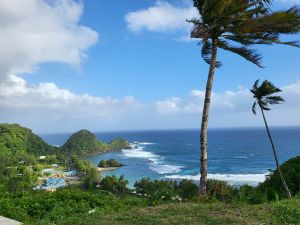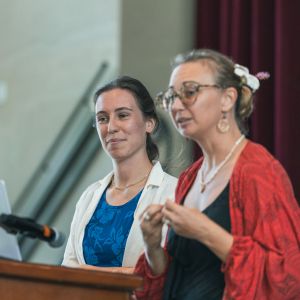


Sea-level rise viewer now available in American Samoa
(Honolulu, HI) – A new interactive sea-level rise viewer for the Territory of American Samoa was recently released to the public, enabling the community to visualize how the shoreline is likely to change from coastal flooding, sea-level rise, hurricane storm surge, and high tides.
The new visualization tool will be an essential component in future planning to assess the short and long-term impacts of rising seas to minimize the risks to coastal communities, infrastructure, and the environment.
A partnership of organizations at the University of Hawai‘i developed the American Samoa Sea Level Rise Viewer over the course of two years, with the Pacific Islands Ocean Observing System (PacIOOS) preparing the platform for the University of Hawaiʻi Sea Level Center (UHSLC) using funding from the Pacific Islands Climate Adaptation Science Center (PI-CASC) and local extension facilitation from Hawai‘i Sea Grant College Program.
While there are other sea-level rise viewers throughout the continental U.S. and Hawai‘i, this mapping tool is of particular importance to American Samoa. Local sea levels have been rising from climate change effects at rates 2.8 times faster than the global average. Beyond that, ever since a devastating 2009 earthquake and tsunami, the lands of American Samoa have been actively sinking, too. This sinking, called subsidence, contributes even more relative change in water levels, with estimates suggesting roughly twice as much total sea-level rise, for these islands, by 2060 than what is predicted from climate effects alone.
Kelley Anderson Tagarino, University of Hawai‘i Sea Grant College Program’s extension agent based at the American Samoa Community College (ASCC), along with local colleagues began to notice a distinct increase of sea levels in tide gauge data, beginning at the time of the 2009 earthquake. She ultimately created a partnership to develop an interactive tool demonstrating sea-level rise projections, engaging Dr. Phil Thompson, his PI-CASC graduate scholar Carla Baizeau of the UHSLC, and the PacIOOS team.
Tagarino noted, “I sought funding for a sea-level rise viewer to empower our community to plan for our future. Now, everyone can use the viewer to zoom in to specific areas and even individual homes, which is critical to developing resilience plans at the village level.” The sea-level rise viewer is already being used to inform the design of the new Pago Pago airport terminal buildings.
Beyond critical infrastructure, the high rates of sea-level rise also threaten natural and cultural resources, agriculture, water resources, critical habitat, and much more. Future plans for the tool include adding the effects of wind and wave activity.
Alphina Liusamoa, a turtle biologist with the American Samoa Department of Maine and Wildlife Resources, is thrilled to find areas included with important ecological zones, like sea turtle nesting beaches on outer islands. “This is incredibly valuable as it allows us to comprehensively assess the risk of rising sea levels to these important nesting habitats. The tool’s interactive nature provides a valuable opportunity for education and outreach, and it can assist us in implementing conservation measures to protect these fragile ecosystems.”
Baizeau traveled from Hawai‘i to join Tagarino and present the sea-level rise viewer to community leaders and other officials throughout the territory, and at Amerika Samoa’s 2nd Annual Disaster Resilience Summit in the last week of September.
“I was lucky enough to go to American Samoa and meet with the village chiefs and students in the schools,” said Baizeau. “Everyone was very interested in learning how to use the viewer so they can start planning for their future. It has been really gratifying to be part of this project, and I hope to continue to improve on the work we’ve started.”
For more information, contact Kelley Anderson Tagarino (kelleyat@hawaii.edu), Cindy Knapman (lknapman@hawaii.edu), Rachel Lentz (rlentz@hawaii.edu), or info@PacIOOS.org.
The University of Hawai‘i Sea Grant College Program is part of the University of Hawai‘i at Mānoa’s prestigious School of Ocean and Earth Science and Technology. It supports an innovative program of research, education, and extension services directed to increasing sustainability of coastal and marine resources and resilience of coastal communities of the state, region, and nation.
Science serving Hawai‘i and the Pacific since 1968.

